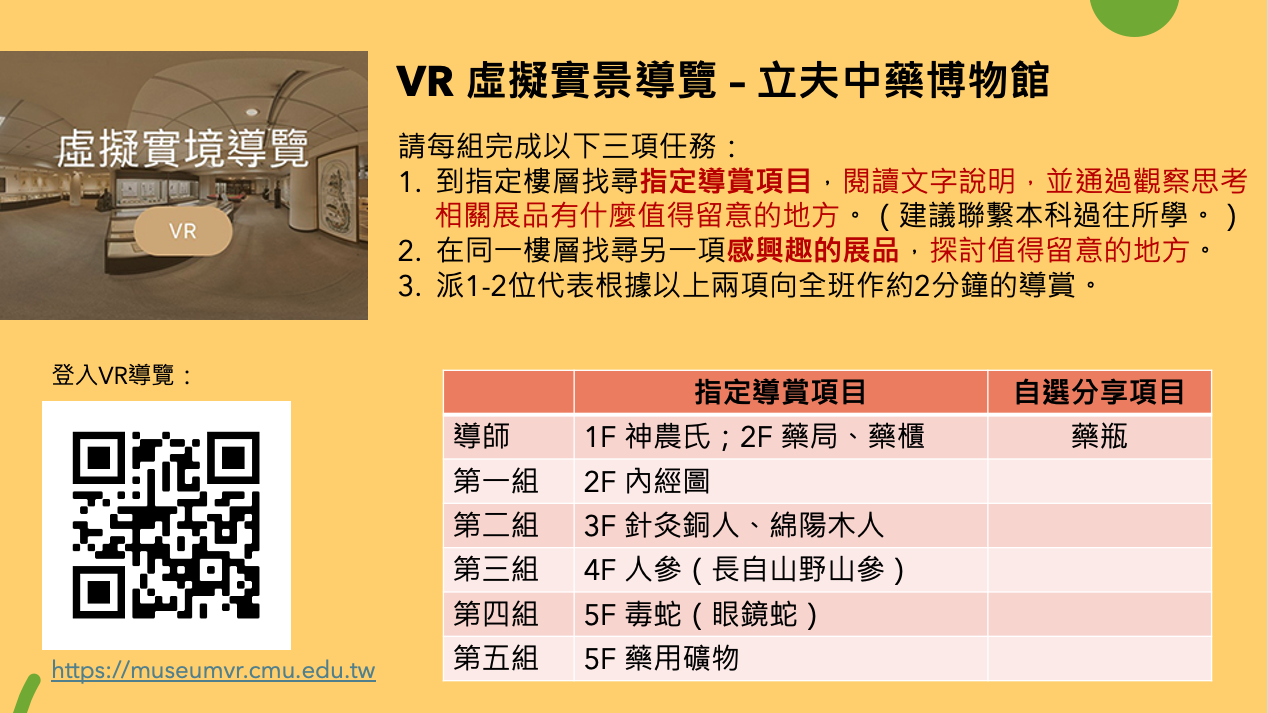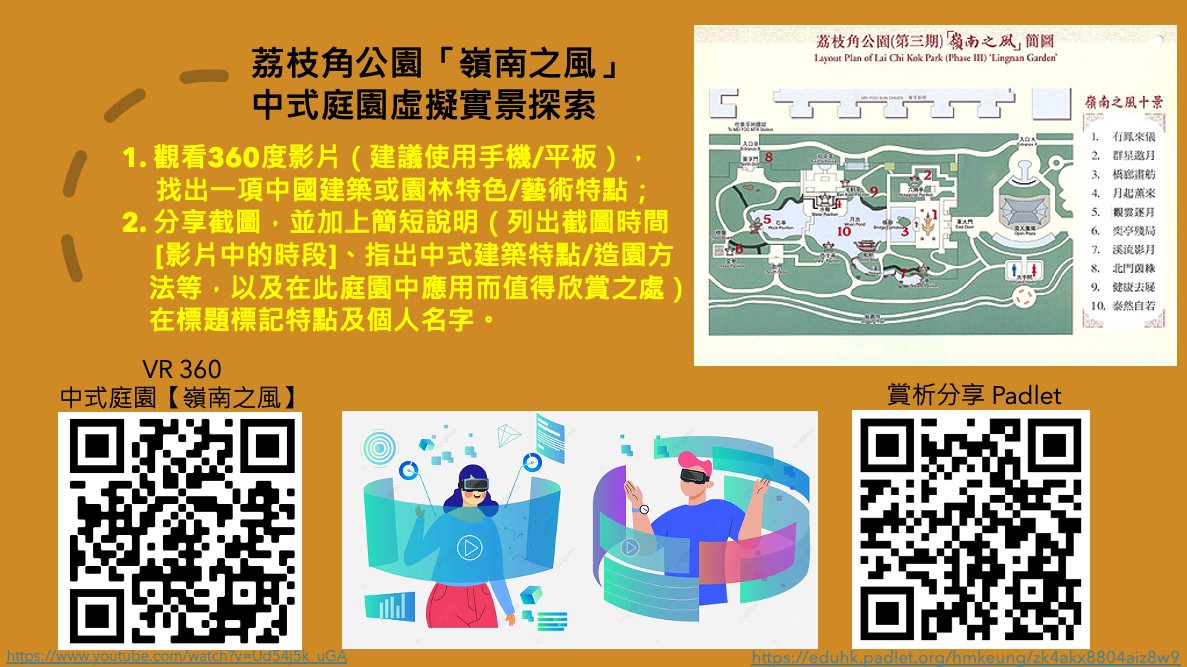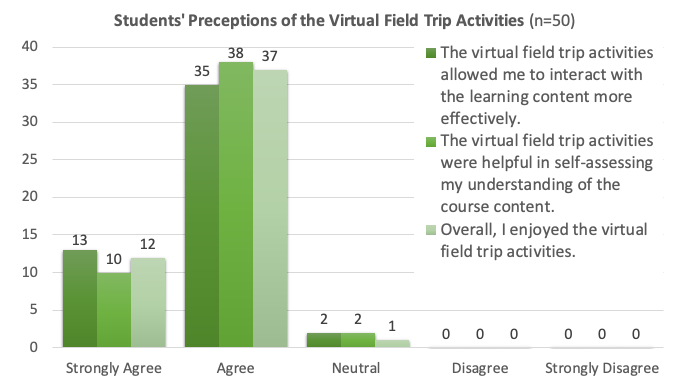
Dr Keung Hiu Man
LCS
Stepping into Virtual Endeavours:
Designing Immersive and Engaging Virtual Field Trips with Online Resources
Virtual Field Trips (VFTs) guide students to explore the world without leaving the classroom. The growing functions of Virtual Reality (VR) and Augmented Reality (AR) add to the variety of digital sources that can be used in VFTs, and help to create more realistic audio-visual simulations of environments and objects that are costly and time-consuming to reach out in real-life. However, pre-made VFTs hardly match well with different curriculum and levels of studies, while creating such content from scratch requires a lot of time and technical skills.
This study aimed to bridge the gap between the pre-made and teacher-created VFTs, by exploring ways to utilise readily available online resources applicable to creating immersive VFTs, and combining them with tailor-made activities to create engaging VFTs fit for a specific learning context. Implications of the findings are discussed to provide insights into the feasibility and benefits of incorporating VFTs into day-to-day lessons in a low-barrier way – with no advanced technical skills, no large investment of time and money, nor VR headsets required.
Virtual Field Trips (VFTs)
Virtual Reality
Interactive Learning Environments
Course Context: Introduction to Chinese Culture
The Major Focus of the Course:
To remind students that although Chinese culture has emerged from thousand years of history, many aspects of the Chinese material and non-material cultures are still highly valuable, and they still have a profound influence on people in our local community and across the globe.
The Problems:
- Many traces of traditional Chinese culture can be found in different aspects of modern life. Still, most students are either unaware of them, or do not have the knowledge and skills needed to appreciate or evaluate them.
- Students found listening to the teacher’s explanation assisted with two-dimensional static illustrations rather boring and difficult to comprehend.
The Challenges:
- No pre-made VFTs fit well with the curriculum.
- Some physical artefacts are found in museums outside Hong Kong.
- More suitable sites for visits are in the mainland or Taiwan.
- Frequent visits to local sites are not possible/ very time-consuming.
The Solution:
- Pre-screen relevant parts of the online sources suitable for forming immersive VFTs, then combine them with tailor-made activities to create engaging VFT experiences fit for the course.
Research Design
Pre-screen online sources suitable for forming immersive VFTs, such as VR tours, 360 videos, AR apps and 3D models. Select specific parts relevant to the course content, then design individual or group-based exploration and follow-up activities.
Common elements of the activities include: i) identifying specific characteristics previously discussed in class, ii) applying what they have learnt to appreciate or evaluate things they have spotted, and iii) sharing their observations.
10 VTFs of varying scales were carried out (ranging from 10 to 45 mins). Students were able to virtually visit 3 sites in Hong Kong and 12 sites from other cities. Students were asked to use a handheld device to view the selected sources, and participate in the activities.
Four types of online resources utilised for creating immersive VFTs:
- VR 360 Images and Videos (e.g. museum and Chinese garden tours): 360 degrees audio-visual simulation of an environment which allows observations in multi-perspectives; viewers can virtually move around the remote site
- AR Objects (e.g. traditional painting presented in an AR app): viewed in a 1:1 ratio or adjusted scale, combines real and virtual, integrated with textual and animated indicators, interactive in real-time
- 3D Models (e.g. 3D interactive artefact models): clearly show the surface texture and inner structure, can be perceived from all sides and angles, and can be turned and zoomed in and out by the viewers
- 2D Photos and Regular Videos: supplement content not available in the sources listed above
Five strategies in designing tailor-made and low-barrier VTF activities:
- Pre-screen Sources: Only select the part(s) relevant to the course.
- Emphasising Accessibility: Choose sources that can be viewed from handheld devices or desktops. Provide HD videos as an alternative if necessary.
- Exploring in Different Districts and Directions: Incorporate sources from different regions to promote global understanding. Allow students to take to the lead to navigate in any direction.
- Applying Classroom Knowledge: Apart from using the sources to assist the teacher’s explanation, try to ask students to i) identify specific characteristics previously discussed in class and ii) apply what they have learnt to appreciate or evaluate things they have spotted.
- Sharing Observations and Views: Assign observation tasks to individuals or groups, and follow up with a sharing session on ZOOM, Padlet or Flipgrid (Ask students to present a screenshot if necessary.)
Examples of VFTs designed for the course:
Research Results
Two groups of students participated in the study. At the end of the course, all students are invited to fill in a questionnaire: In the first part, each student needs to answer 13 questions with a 5-point Likert scale, and in the second part, students can freely share their experiences and views on the VTFs.
Fifty students responded to the questionnaire. 98% of the students indicated that they had enjoyed the VFTs (24% strongly agree, 74% agree), only 2% indicated neutral, and none indicated that he/she did not enjoy them.
As compared to looking at 2D photos and watching regular videos, the majority of the students agreed or strongly agreed that:
- Observing in VR creates a more immersive experience (24% Strongly Agree; 76% Agree)
- Observing through AR creates a better visualisation experience (22% Strongly Agree; 76% Agree; 2% neutral)
- Observing 3D models create a more physically-hands-on experience (28% Strongly Agree; 72% Agree; 2% neutral)
The majority of the students also agreed or strongly agreed with the following benefits of incorporating VFTs in this course:
- Interact with the learning content more effectively (26% Strongly Agree; 74% Agree; 2% neutral)
- Helpful in conducting self-assessment (20% Strongly Agree; 76% Agree; 4% neutral)
- Provide a platform for meaningful discussion (30% Strongly Agree; 62% Agree; 8% neutral)
- Increase learning motivation (26% Strongly Agree; 66% Agree; 8% neutral)
- Create individual observations on the features of Chinese culture, which enriched the learning experience (32% Strongly Agree; 58% Agree; 10% neutral)
- Become a more active learner (20% Strongly Agree; 66% Agree; 14% neutral)
Responses from parts one and two of the questionnaire largely correspond, except for the perceived ease of use: Most students (94%) indicated that the materials for VFTs were user-friendly. Individual students shared the difficulties encountered – one of the AR apps is difficult to operate; certain parts of the materials cannot be zoomed in; not convenient to use more than one device (1 for Zoom class and 1 for VFTs). More directions on the operation can be delivered, and searching for additional information can be encouraged. The problem of using two devices will be resolved when face-to-face lessons are resumed.
Diverse views were found regarding the comparison between VFTs and the authentic field trips: Quite a number of students believed that VFTs are good alternatives, regardless of the Covid restrictions. One student thought VFTs are different from authentic visits, and should be regarded as a contingency plan under the pandemic. It should be communicated to the students that VFTs are not designed to completely replace all authentic visits, but to enhance learning experiences under the limited class time and logistic constraints.
Selected feedback from students:
“I found the activities novel and interesting.”
“I am inspired to incorporate online exploration materials into my design of learning activities.”
“Visiting museums without leaving home and virtually walking around the site to appreciate the exhibition is a very valuable and nice option.”
“As compared to the ordinary explanations assisted by PowerPoint slides, virtual field trips work better in creating first-hand cultural experiences.”
“VR or AR can better present contents that are relatively difficult to comprehend, such as the pen strokes in paintings and the architectural features in gardens, and they can help with understanding. At the same time, this form of presentation gives a sense that I am personally on the scene, which deepens the impression and interest in learning.”
Conclusions
Incorporating Virtual Field Trips into day-to-day lessons is not necessarily very difficult. By combining readily available sources with tailor-made activities, teachers can create appropriate and engaging VFTs in a few easy steps. Using handheld devices to explore simplifies the logistics and facilitates screen captures, encouraging students to develop their own observations for personal expression and discussion with others.
The positive feedback from students suggested that VFTs can enhance the learning experiences, increase learning motivation, assist self-assessment, and inspire the application of classroom knowledge in real-life situations. VFTs are not designed to completely replace authentic field trips, but the innovative use of this blended mode of learning can help to achieve many benefits of field trips and reach places in other ways not possible under the limited class time and logistic constraints. Virtual visits to sites across the border and around the globe will also open up valuable opportunities to learn about cultural diversity and global perspectives.



